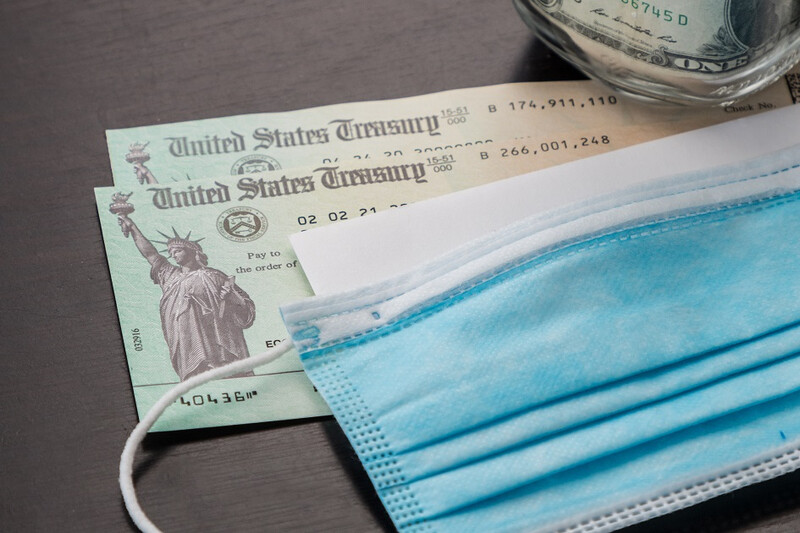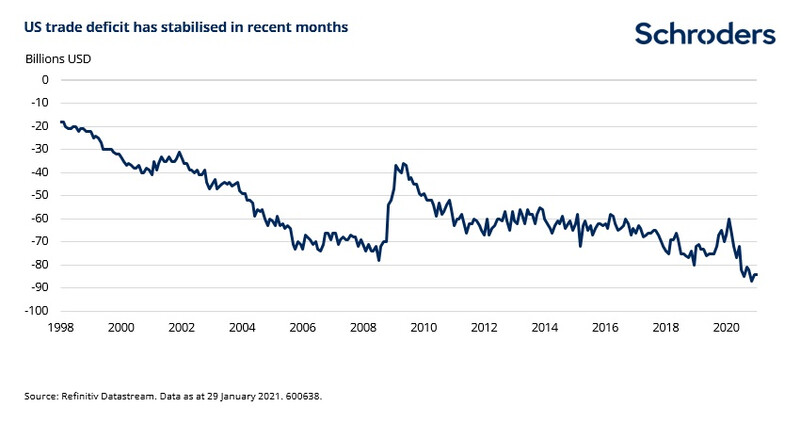Does the US dollar have further to fall?
The brighter outlook for US economy is not necessary a boon for the US dollar. We look at what’s next for the currency after its recent stability.

Authors
After falling in the second half of 2020, the US dollar has shown more resilience this year. Given the importance of the dollar for markets, the question now is if the recent stability signals the end of dollar weakness or if further depreciation is on the cards.
To find an answer, we have revisited some the key headwinds for the dollar that we highlighted in our article late last year. In short, the dollar-negative structural drivers are still in place and could reassert themselves sooner rather than later.
Importantly, the recent developments on the fiscal front highlight the inherent trade-off in stimulating the economy with government spending. What is good for growth, might not be good for currency.
In the near term, the dollar’s fate will hang on the willingness of foreigner investors to purchase US bonds and other assets on the back of the sharp increase in US yields.

US current account deficit is likely to increase further
One of the key reasons for the dollar’s weakness since mid-2020 has been the widening of the US current account deficit. The deficit has increased mainly because of the sharp deterioration in the trade balance, with US imports recovering much faster than exports from the Covid-19 induced slump.
Looking at the latest data, the US trade balance recorded an $85 billion deficit in January. While this is $20 billion more than at the same time in last year, the deficit has stabilised somewhat in recent months, as seen in the figure below. This can, at least partially, explain the firmer footing of the dollar so far in 2021. However, the respite could be short-lived in light of the recent fiscal policy developments.

Emboldened by winning the US presidential election in November and the Senate majority in January, the Democratic Party moved fast in passing the next round of fiscal stimulus. After votes in the two houses of Congress, President Biden signed the $1.9 trillion stimulus package into law on 11 March.
The package consists of a slew of measures aimed at mitigating the short- and long-term effects of the pandemic. The two most imminent measures include $1,400 stimulus checks to all households earning less than $160,000 per year and the extension of $300 per week enhanced unemployment benefit through 6 September 2021.
As we have previously highlighted, a very different fiscal response can explain the sharp increase in the US current account deficit in the Covid-19 crisis. First, the magnitude of additional government spending has been remarkable, with the three fiscal packages since March 2020 amounting to $5 trillion. That’s almost 25% of GDP.
Second, some of the key measures have been aimed at people at lower income levels. Crucially, these people are more likely to spend the windfall. By giving money directly to households, the government has been effectively subsidising consumption. With the US importing a large share of consumer goods, this has a direct negative impact on the trade balance.
The figure below shows how US retail sales have rebounded swiftly from the slump. In January, core retail sales rose by 6%, taking the annual growth rate to 14%, the highest ever. There was some payback in February with sales falling, but this was effected by unusually cold weather.
Looking ahead, the $1,400 stimulus checks will go out over the course of March. Furthermore, US households have accumulated significant savings in the Covid-19 crisis. As the economy continues to open up, at least some of these savings will be spent. This will add more fire to the fuel, meaning that the US current account deficit is likely to start widening again after rising from 2% to 4% of GDP in 2020.

What level of current account deficit is sustainable?
Historically, a widening US current account deficit has been associated with a weaker dollar. Granted, this relationship has not been perfect. So should investors expect the dollar to continue to weaken on the back of widening deficit?
The large fiscal stimulus and the relative success of the US vaccination campaign means that the country is ahead of most other countries in the pandemic recovery. The US is likely to outgrow other developed market countries in 2021.
This is good news for growth-sensitive assets, such as equities, perhaps less so for the dollar. In fact, faster growth, if financed by an increase in budget deficit, often leads to a weaker currency. This has been a staple relationship in emerging markets, where weaker currency is often a payback for faster growth.
As explained, greater spending, at least in the short-term, tends to increase imports and widen the current account deficit. Since the deficit must be the financed by the financial account surplus, foreigners must commensurately increase the purchases of a countries assets. If the foreign demand is insufficient, the currency will have to bear the brunt and weaken, in order to make the two sides of the balance of payments to equalise.
While clearly, the US differs from other countries because of the reserve currency status of the dollar, it is still affected by the same forces. Furthermore, the US had a significant structural budget deficit even before the Covid-19 crisis, so additional spending has only magnified the issue.
The key question then is, what level of current account deficit can the US sustain without putting pressure on the dollar.
Fed’s policy is reducing the efficacy of stabilisers
As explained in our previous article, fiscal and monetary policy are, in essence, two sides of the same coin. If one is loose, the other generally has to be tight and vice versa. This works as a stabilising mechanism.
Higher interest rates, all other things equal, help to reduce the current account deficit by discouraging consumption and making countries’ bonds more attractive to foreign investors.
However, the Federal Reserve’s (Fed) framework of average inflation targeting (AIT) means that this stabilising mechanism is impaired. At the latest Federal Open Market Committee (FOMC) meeting on 17 March, the Fed indicated that it does not see a need to increase interest rates until at least 2024.
Granted, the Fed has less control on the long end of the yield curve. That is why the yields of longer dated US bonds have increased sharply in the last few months, despite the Fed’s $120 billion monthly asset purchases. Consequently, the yield advantage of US bonds has increased over the rest of the world.
So far, the Fed has been sanguine about the developments with the long yields. However, it’s possible that the they will try to quell the rise in long-term yields. Such a policy would reduce the yield advantage of US assets and support for the dollar.
In any case, the next few months will provide valuable clues on foreign demand of US assets. Will foreign investors be lured in by higher US yields and expectations of faster growth? Or will they be concerned about unprecedented budget deficit, increasing current account deficit and possible fall in the dollar?
The evidence so far indicates that foreign investors are not showing great interest in US bonds.
Foreigners have shown little interest in US bonds (with one exception)
The US Treasury market experienced a historic shock in March 2020, forcing the Fed to spend more than $1.5 trillion to restore the order. It was partially caused by foreign investors selling Treasuries in unprecedented volumes. A year later, the foreign demand has not returned.
In 2020, the net foreign sales of long-term Treasury securities amounted close to half a trillion dollars, with both public and private investors sheading their holdings (see figure below). This has continued in 2021. In January, the foreign sales of Treasuries amounted to $50 billion.
Given the US dollar’s reserve currency status, it is concerning that the public investors’ demand for Treasuries has been very lacklustre at the time when global FX reserves have been increasing.
Looking briefly at other types of bonds, foreign investors have been also selling corporate bonds in significant volumes, despite the yield advantage of US bonds. The only types of bonds that have seen a sizable demand are agency bonds, with foreign purchases picking up in the second half of 2020.
Interestingly, the majority of the agency purchases have come from Japan. This can, at least partially, be explained by large Japanese institutional investors increasing their quota of foreign assets. Nonetheless, the demand for agencies is unlikely to be sufficient to make up for the lack of demand for Treasuries.

With the US emerging from the Covid-19 pandemic faster than the rest of the world, the sentiment on the dollar has improved. Also, US trade balance has been more stable recently, after the deterioration in 2020. These factors could explain the stability of the dollar in early 2021. However, looking further ahead, the fiscal policy is leading to a wider current account deficit. Unless foreign demand for US assets, especially US Treasury bonds, increases materially, financing of that deficit might require a weaker dollar.
Authors
Topics